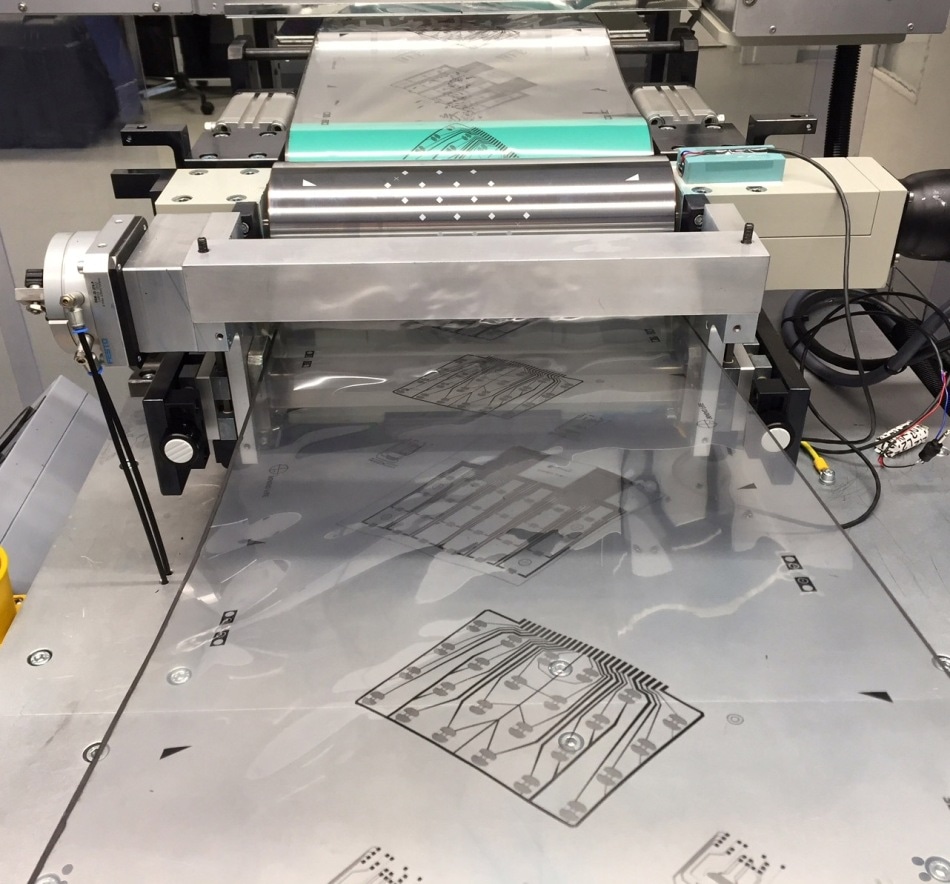Mar 7 2018
Cell-based biosensors have the ability to reproduce the effect of different substances (for example, drugs) on the human body in the lab. Yet, based on the measuring principle, it is very costly to produce these biosensors.
Consequently, they are mostly not applied. Complicated production process and high-cost electrode material are the cost factors for sensors that carry out electrical measurements. At present, Fraunhofer researchers are simply and inexpensively fabricating biosensors with graphene electrodes through roll-to-roll printing process. There is already a system prototype for large-scale production.
 Endless film with printed biosensors: Fraunhofer has developed a convenient roll-to-roll process. (Image credit: Fraunhofer IBMT)
Endless film with printed biosensors: Fraunhofer has developed a convenient roll-to-roll process. (Image credit: Fraunhofer IBMT)
Cell-based biosensors evaluate variations in cell cultures through electrical signals. They perform this through electrodes installed inside the Petri dish or the wells of the well-known well plate. For instance, in the event of added viruses breaking down a continuous layer of cells on the electrodes, there is a decrease in the electrical resistance evaluated between the electrodes.
Thus, the impact of drugs or vaccines, for instance, can be investigated: the effectiveness of the active ingredient is inversely proportional to the number of cells destroyed by the viruses as well as the measured resistance change. Moreover, toxicity investigations (for example, on cosmetic products) can work based on the same principle and may substitute in the future animal experiments. One more benefit is that if biosensors are connected to an evaluation unit, evaluations can be performed in an automated and continuous manner.
Conductive, Biocompatible, Printable
However, the biosensors are very costly and complicated to produce because the electrodes are formed of an electrically conductive and biocompatible material, such as platinum or gold. The fabrication of microelectrodes involves a complex lithographic process.
Here is the outcome: In general, the labs do not purchase these biosensors due to their higher costs, and the investigation of the cell cultures continues to be manually carried out under a microscope. However, at present, graphene could be used as a material for the electrodes, in the place of valuable metals. The benefits of graphene are that it is biocompatible, electrically conductive, and can be printed on surfaces, if in ink-form.
Researchers from the Fraunhofer Institute for Biomedical Engineering IBMT in St. Ingbert in Germany’s Saarland region have used a similar graphene ink. In collaboration with industry partners in the M-era.Net project BIOGRAPHY, funded by the German Federal Ministry of Education and Research (BMBF), they have devised a printing process which enables the production of graphene biosensors in large numbers by using a cost-efficient roll-to-roll process.
“Our system prototype can print about 400 biosensors per minute on a continuous foil,” stated Dr. Thomas Velten, Head of the Biomedical Microsystems Department at IBMT and Project Manager of BIOGRAPHY, describing the outcome of the development study. The graphene ink and printing equipment have been offered by the partners, and the printing process has been devised by the researchers at the IBMT.
In particular, it is crucial to adjust parameters such as the ink viscosity, printing speed, doctor blade pressure—a doctor blade wipes off excess ink—and well depth of the printing cylinder so that the printed structures correspond to the nominal dimensions.
Thomas Velten
An interdisciplinary group of engineers and biologists from the IBMT have also synthesized a protein ink that can be directly printed onto the electrodes next to graphene. Velten stated that “It’s only thanks to the proteins that the cells adhere well enough to the electrode foil.”
It is a complex process as the surface energies of the ink and the foil have to be matched with one another such that the ink is conveyed from the printing cylinder to the foil in an optimal manner. Specifically crucial is the drying of the printed structures as the proteins do not have the resiliency to withstand high temperatures or solvents. Only the appropriate blend of drying method and ink ingredients makes sure that the ink gets dried quickly.
The practical investigations of the printed biosensors will be done once the prototype is successfully developed. According to Project Manager Velten, “We expect to be able to offer the industry a universal technology platform in no later than a year.”